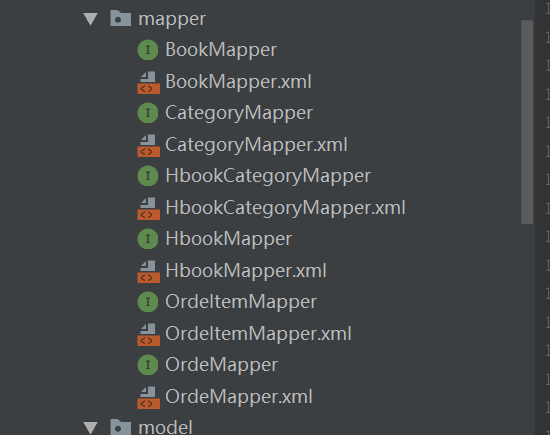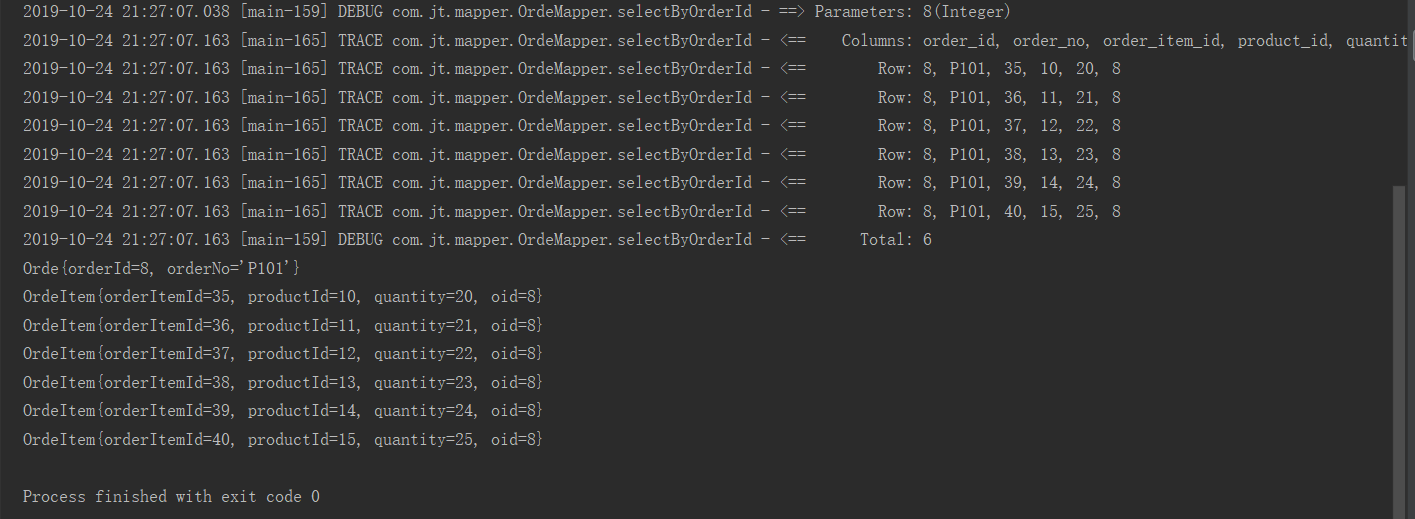前言:
在我们之前的hibernate中我们是学过了关联关系的,
所以我们在本章给讲一讲mybatis的关联关系。
mybatis的关联关系
一对多的测试
1.通过逆向工程生成Hbook,HbookCategory,Category
如何生成,可以参考之前的
这次我们要用到五张数据库表
<table schema="" tableName="t_hibernate_order" domainObjectName="Order" enableCountByExample="false" enableDeleteByExample="false" enableSelectByExample="false" enableUpdateByExample="false"> </table> <table schema="" tableName="t_hibernate_order_item" domainObjectName="OrderItem" enableCountByExample="false" enableDeleteByExample="false" enableSelectByExample="false" enableUpdateByExample="false"> </table> <table schema="" tableName="t_hibernate_book" domainObjectName="Hbook" enableCountByExample="false" enableDeleteByExample="false" enableSelectByExample="false" enableUpdateByExample="false"> </table> <table schema="" tableName="t_hibernate_category" domainObjectName="Category" enableCountByExample="false" enableDeleteByExample="false" enableSelectByExample="false" enableUpdateByExample="false"> </table> <table schema="" tableName="t_hibernate_book_category" domainObjectName="HbookCategory" enableCountByExample="false" enableDeleteByExample="false" enableSelectByExample="false" enableUpdateByExample="false"> </table>
生成之后目录

OrderVo
package com.jt.model.vo; import com.jt.model.Orde; import com.jt.model.OrdeItem; import java.util.ArrayList; import java.util.List; /** * @author jt * @site www.xiaomage.com * @company xxx公司 * @create 2019-10-23 18:59 */ public class OrderVo extends Orde { private List<OrdeItem> orderItems=new ArrayList<>(); public List<OrdeItem> getOrderItems() { return orderItems; } public void setOrderItems(List<OrdeItem> orderItems) { this.orderItems = orderItems; } }
OrderItemVo
package com.jt.model.vo; import com.jt.model.Orde; import com.jt.model.OrdeItem; /** * @author jt * @site www.xiaomage.com * @company xxx公司 * @create 2019-10-23 19:01 */ public class OrderItemVo extends OrdeItem { private Orde orde; public Orde getOrde() { return orde; } public void setOrde(Orde orde) { this.orde = orde; } }
CategoryVo
package com.jt.model.vo; import com.jt.model.Category; import com.jt.model.Hbook; import java.util.ArrayList; import java.util.List; /** * @author jt * @site www.xiaomage.com * @company xxx公司 * @create 2019-10-23 20:08 */ public class CategoryVo extends Category { private List<Hbook> hbooks=new ArrayList<>(); public List<Hbook> getHbooks() { return hbooks; } public void setHbooks(List<Hbook> hbooks) { this.hbooks = hbooks; } }
HbookVo
package com.jt.model.vo; import com.jt.model.Category; import com.jt.model.Hbook; import java.util.ArrayList; import java.util.List; /** * @author jt * @site www.xiaomage.com * @company xxx公司 * @create 2019-10-23 20:06 */ public class HbookVo extends Hbook { private List<Category> categories=new ArrayList<>(); // public List<Category> getCategories() { // return categories; // } // // public void setCategories(List<Category> categories) // { // this.categories = categories; // } public List<Category> getCategories() { return categories; } public void setCategories(List<Category> categories) { this.categories = categories; } }
4.做一个测试(根据id来查询)
@Test public void selectByOrderItemId() { List<OrderItemVo> orderItemVos = oneToManyService.selectByOrderItemId(36); OrderItemVo orderItemVo=orderItemVos.get(0); System.out.println(orderItemVo); System.out.println(orderItemVo.getOrde()); } @Test public void selectByOrderId() { List<OrderVo> orderVos = oneToManyService.selectByOrderId(8); OrderVo orderVo=orderVos.get(0); // System.out.println(orderVos.size()); System.out.println(orderVo); for (OrdeItem orderItem : orderVo.getOrderItems()) { System.out.println(orderItem); } }
通过一个订单项的id,查询出订单项信息的同时,查询出所属的订单
通过一个订单id,查询出订单信息的同时,查询出所有的订单项
2、多对多关联关系
首先先用逆向生成工具生成t_hibernate_book、t_hibernate_book_category(可生成可不生成)、t_hibernate_category,这两张表对应的model与mapper
generatorConfig.xml
<?xml version="1.0" encoding="UTF-8" ?> <!DOCTYPE generatorConfiguration PUBLIC "-//mybatis.org//DTD MyBatis Generator Configuration 1.0//EN" "http://mybatis.org/dtd/mybatis-generator-config_1_0.dtd" > <generatorConfiguration> <!-- 引入配置文件 --> <properties resource="jdbc.properties"/> <!--指定数据库jdbc驱动jar包的位置--> <classPathEntry location="D:\initpath\mvn_repository\mysql\mysql-connector-java\5.1.44\mysql-connector-java-5.1.44.jar"/> <!-- 一个数据库一个context --> <context id="infoGuardian"> <!-- 注释 --> <commentGenerator> <property name="suppressAllComments" value="true"/><!-- 是否取消注释 --> <property name="suppressDate" value="true"/> <!-- 是否生成注释代时间戳 --> </commentGenerator> <!-- jdbc连接 --> <jdbcConnection driverClass="${jdbc.driver}" connectionURL="${jdbc.url}" userId="${jdbc.username}" password="${jdbc.password}"/> <!-- 类型转换 --> <javaTypeResolver> <!-- 是否使用bigDecimal, false可自动转化以下类型(Long, Integer, Short, etc.) --> <property name="forceBigDecimals" value="false"/> </javaTypeResolver> <!-- 01 指定javaBean生成的位置 --> <!-- targetPackage:指定生成的model生成所在的包名 --> <!-- targetProject:指定在该项目下所在的路径 --> <javaModelGenerator targetPackage="com.jt.model" targetProject="src/main/java"> <!-- 是否允许子包,即targetPackage.schemaName.tableName --> <property name="enableSubPackages" value="false"/> <!-- 是否对model添加构造函数 --> <property name="constructorBased" value="true"/> <!-- 是否针对string类型的字段在set的时候进行trim调用 --> <property name="trimStrings" value="false"/> <!-- 建立的Model对象是否 不可改变 即生成的Model对象不会有 setter方法,只有构造方法 --> <property name="immutable" value="false"/> </javaModelGenerator> <!-- 02 指定sql映射文件生成的位置 --> <sqlMapGenerator targetPackage="com.jt.mapper" targetProject="src/main/java"> <!-- 是否允许子包,即targetPackage.schemaName.tableName --> <property name="enableSubPackages" value="false"/> </sqlMapGenerator> <!-- 03 生成XxxMapper接口 --> <!-- type="ANNOTATEDMAPPER",生成Java Model 和基于注解的Mapper对象 --> <!-- type="MIXEDMAPPER",生成基于注解的Java Model 和相应的Mapper对象 --> <!-- type="XMLMAPPER",生成SQLMap XML文件和独立的Mapper接口 --> <javaClientGenerator targetPackage="com.jt.mapper" targetProject="src/main/java" type="XMLMAPPER"> <!-- 是否在当前路径下新加一层schema,false路径com.oop.eksp.user.model, true:com.oop.eksp.user.model.[schemaName] --> <property name="enableSubPackages" value="false"/> </javaClientGenerator> <!-- 配置表信息 --> <!-- schema即为数据库名 --> <!-- tableName为对应的数据库表 --> <!-- domainObjectName是要生成的实体类 --> <!-- enable*ByExample是否生成 example类 --> <!--<table schema="" tableName="t_book" domainObjectName="Book"--> <!--enableCountByExample="false" enableDeleteByExample="false"--> <!--enableSelectByExample="false" enableUpdateByExample="false">--> <!--<!– 忽略列,不生成bean 字段 –>--> <!--<!– <ignoreColumn column="FRED" /> –>--> <!--<!– 指定列的java数据类型 –>--> <!--<!– <columnOverride column="LONG_VARCHAR_FIELD" jdbcType="VARCHAR" /> –>--> <!--</table>--> <!-- <table schema="" tableName="t_hibernate_order" domainObjectName="Orde" enableCountByExample="false" enableDeleteByExample="false" enableSelectByExample="false" enableUpdateByExample="false"> <!– 忽略列,不生成bean 字段 –> <!– <ignoreColumn column="FRED" /> –> <!– 指定列的java数据类型 –> <!– <columnOverride column="LONG_VARCHAR_FIELD" jdbcType="VARCHAR" /> –> </table>--> <!--<table schema="" tableName="t_hibernate_order_item" domainObjectName="OrdeItem" enableCountByExample="false" enableDeleteByExample="false" enableSelectByExample="false" enableUpdateByExample="false"> <!– 忽略列,不生成bean 字段 –> <!– <ignoreColumn column="FRED" /> –> <!– 指定列的java数据类型 –> <!– < columnOverride column="LONG_VARCHAR_FIELD" jdbcType="VARCHAR" /> –> </table>--> <table schema="" tableName="t_hibernate_book`" domainObjectName="Hbook" enableCountByExample="false" enableDeleteByExample="false" enableSelectByExample="false" enableUpdateByExample="false"> <!-- 忽略列,不生成bean 字段 --> <!-- <ignoreColumn column="FRED" /> --> <!-- 指定列的java数据类型 --> <!-- <columnOverride column="LONG_VARCHAR_FIELD" jdbcType="VARCHAR" /> --> </table> <!--<table schema="" tableName="t_hibernate_category" domainObjectName="Category" enableCountByExample="false" enableDeleteByExample="false" enableSelectByExample="false" enableUpdateByExample="false"> <!– 忽略列,不生成bean 字段 –> <!– <ignoreColumn column="FRED" /> –> <!– 指定列的java数据类型 –> <!– <columnOverride column="LONG_VARCHAR_FIELD" jdbcType="VARCHAR" /> –> </table>--> <!-- <table schema="" tableName="t_hibernate_book_category" domainObjectName="HbookCategory" enableCountByExample="false" enableDeleteByExample="false" enableSelectByExample="false" enableUpdateByExample="false"> <!– 忽略列,不生成bean 字段 –> <!– <ignoreColumn column="FRED" /> –> <!– 指定列的java数据类型 –> <!– <columnOverride column="LONG_VARCHAR_FIELD" jdbcType="VARCHAR" /> –> </table>--> </context> </generatorConfiguration>
HBookMapper
package com.jt.mapper; import com.jt.model.Hbook; import com.jt.model.vo.HbookVo; import org.apache.ibatis.annotations.Param; import org.springframework.stereotype.Repository; @Repository public interface HbookMapper { int deleteByPrimaryKey(Integer bookId); int insert(Hbook record); int insertSelective(Hbook record); Hbook selectByPrimaryKey(Integer bookId); int updateByPrimaryKeySelective(Hbook record); int updateByPrimaryKey(Hbook record); HbookVo selectByBid(@Param("bid") Integer bid); }
HBookMapper.xml
<?xml version="1.0" encoding="UTF-8" ?> <!DOCTYPE mapper PUBLIC "-//mybatis.org//DTD Mapper 3.0//EN" "http://mybatis.org/dtd/mybatis-3-mapper.dtd" > <mapper namespace="com.jt.mapper.HbookMapper" > <resultMap id="BaseResultMap" type="com.jt.model.Hbook" > <constructor > <idArg column="book_id" jdbcType="INTEGER" javaType="java.lang.Integer" /> <arg column="book_name" jdbcType="VARCHAR" javaType="java.lang.String" /> <arg column="price" jdbcType="REAL" javaType="java.lang.Float" /> </constructor> </resultMap> <resultMap id="HbookVoMap" type="com.jt.model.vo.HbookVo"> <result property="bookId" column="book_id"></result> <result property="bookName" column="book_name"></result> <result property="price" column="price"></result> <!-- <result property="orderItems"></result>--> <collection property="categories" ofType="com.jt.model.Category"> <result property="categoryId" column="category_id"></result> <result property="categoryName" column="category_name"></result> </collection> </resultMap> <sql id="Base_Column_List" > book_id, book_name, price </sql> <select id="selectByPrimaryKey" resultMap="BaseResultMap" parameterType="java.lang.Integer" > select <include refid="Base_Column_List" /> from t_hibernate_book where book_id = #{bookId,jdbcType=INTEGER} </select> <delete id="deleteByPrimaryKey" parameterType="java.lang.Integer" > delete from t_hibernate_book where book_id = #{bookId,jdbcType=INTEGER} </delete> <insert id="insert" parameterType="com.jt.model.Hbook" > insert into t_hibernate_book (book_id, book_name, price ) values (#{bookId,jdbcType=INTEGER}, #{bookName,jdbcType=VARCHAR}, #{price,jdbcType=REAL} ) </insert> <insert id="insertSelective" parameterType="com.jt.model.Hbook" > insert into t_hibernate_book <trim prefix="(" suffix=")" suffixOverrides="," > <if test="bookId != null" > book_id, </if> <if test="bookName != null" > book_name, </if> <if test="price != null" > price, </if> </trim> <trim prefix="values (" suffix=")" suffixOverrides="," > <if test="bookId != null" > #{bookId,jdbcType=INTEGER}, </if> <if test="bookName != null" > #{bookName,jdbcType=VARCHAR}, </if> <if test="price != null" > #{price,jdbcType=REAL}, </if> </trim> </insert> <update id="updateByPrimaryKeySelective" parameterType="com.jt.model.Hbook" > update t_hibernate_book <set > <if test="bookName != null" > book_name = #{bookName,jdbcType=VARCHAR}, </if> <if test="price != null" > price = #{price,jdbcType=REAL}, </if> </set> where book_id = #{bookId,jdbcType=INTEGER} </update> <update id="updateByPrimaryKey" parameterType="com.jt.model.Hbook" > update t_hibernate_book set book_name = #{bookName,jdbcType=VARCHAR}, price = #{price,jdbcType=REAL} where book_id = #{bookId,jdbcType=INTEGER} </update> <select id="selectByBid" resultMap="HbookVoMap" > select * from t_hibernate_book b,t_hibernate_book_category bc,t_hibernate_category c where b.book_id=bc.bid and bc.cid=c.category_id and b.book_id=#{bid} </select> </mapper>
HBookCategoryMapper
package com.jt.mapper; import com.jt.model.HbookCategory; public interface HbookCategoryMapper { int deleteByPrimaryKey(Integer bcid); int insert(HbookCategory record); int insertSelective(HbookCategory record); HbookCategory selectByPrimaryKey(Integer bcid); int updateByPrimaryKeySelective(HbookCategory record); int updateByPrimaryKey(HbookCategory record); }
HBookCategoryMapper.xml
<?xml version="1.0" encoding="UTF-8" ?> <!DOCTYPE mapper PUBLIC "-//mybatis.org//DTD Mapper 3.0//EN" "http://mybatis.org/dtd/mybatis-3-mapper.dtd" > <mapper namespace="com.jt.mapper.HbookCategoryMapper" > <resultMap id="BaseResultMap" type="com.jt.model.HbookCategory" > <constructor > <idArg column="bcid" jdbcType="INTEGER" javaType="java.lang.Integer" /> <arg column="bid" jdbcType="INTEGER" javaType="java.lang.Integer" /> <arg column="cid" jdbcType="INTEGER" javaType="java.lang.Integer" /> </constructor> </resultMap> <sql id="Base_Column_List" > bcid, bid, cid </sql> <select id="selectByPrimaryKey" resultMap="BaseResultMap" parameterType="java.lang.Integer" > select <include refid="Base_Column_List" /> from t_hibernate_book_category where bcid = #{bcid,jdbcType=INTEGER} </select> <delete id="deleteByPrimaryKey" parameterType="java.lang.Integer" > delete from t_hibernate_book_category where bcid = #{bcid,jdbcType=INTEGER} </delete> <insert id="insert" parameterType="com.jt.model.HbookCategory" > insert into t_hibernate_book_category (bcid, bid, cid ) values (#{bcid,jdbcType=INTEGER}, #{bid,jdbcType=INTEGER}, #{cid,jdbcType=INTEGER} ) </insert> <insert id="insertSelective" parameterType="com.jt.model.HbookCategory" > insert into t_hibernate_book_category <trim prefix="(" suffix=")" suffixOverrides="," > <if test="bcid != null" > bcid, </if> <if test="bid != null" > bid, </if> <if test="cid != null" > cid, </if> </trim> <trim prefix="values (" suffix=")" suffixOverrides="," > <if test="bcid != null" > #{bcid,jdbcType=INTEGER}, </if> <if test="bid != null" > #{bid,jdbcType=INTEGER}, </if> <if test="cid != null" > #{cid,jdbcType=INTEGER}, </if> </trim> </insert> <update id="updateByPrimaryKeySelective" parameterType="com.jt.model.HbookCategory" > update t_hibernate_book_category <set > <if test="bid != null" > bid = #{bid,jdbcType=INTEGER}, </if> <if test="cid != null" > cid = #{cid,jdbcType=INTEGER}, </if> </set> where bcid = #{bcid,jdbcType=INTEGER} </update> <update id="updateByPrimaryKey" parameterType="com.jt.model.HbookCategory" > update t_hibernate_book_category set bid = #{bid,jdbcType=INTEGER}, cid = #{cid,jdbcType=INTEGER} where bcid = #{bcid,jdbcType=INTEGER} </update> </mapper>
测试方法
@Autowired private ManyToManyService manyToManyService; @Test public void selectByBid() { HbookVo hbookVo = manyToManyService.selectByBid(8); System.out.println(hbookVo); for (Category category : hbookVo.getCategories()) { System.out.println(category); } } @Test public void selectByCid() { CategoryVo categoryVo=this.manyToManyService.selectByCid(8); System.out.println(categoryVo); for (Hbook hbook : categoryVo.getHbooks()) { System.out.println(hbook); } }
